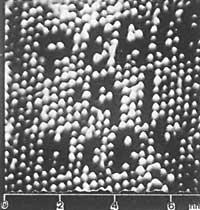Atomic Writing
The message is peace 91, Hitachi Central Research Laboratory. To read this message, a microscope is necessary to expand at least ten million letters. And it is that these letters are written atoms to atoms, whose height is one million millimeters.
To achieve this brand, Mr. Shigeyuki Hosoki and his co-workers have had to develop individual atoms extraction technology from the surface of a solid in Tokyo. For this purpose, a microscope of effect tunnels was used. This microscope was invented in 1982 and four years later the Sres. Gerd Binning and Heinrich Rohrer won the Nobel Prize in Physics for this invention.

It cleans the surface of a solid with a fine punch located at some angstroms (angstroma is the millimeter hamarmilion). The punch is sensitive to the surface characteristics that run. By measuring the perturbations recorded by the probe, the image of the sample analyzed with the help of the computer treatment is obtained.
In the Japanese essay, the support used is the sulfur and molybdenum alloy and the tungsten punch. The punch has been initially at a distance of 10 angstromas of the surface, that is, at a suitable distance for the study of the surface with tunnel effect. Then, when the punch was at the height of the atom they aspired to remove it, Hitachi researchers have reduced the distance between the probe and the surface to less than 3 angstrom.
At that time, the probe has been subjected to 5.5 volt electrical pulses in the seven hundredths of a second for the individual extraction of the selected atoms.
In the California city of San Jose, researchers Donald Eigler and Ehrard Schweizer from IBM conducted a similar essay. The xenon gas atoms, glued one by one in a nickel crystal for 22 hours, wrote the letters IBM. American researchers worked for this at a very low temperature (-269 Canal C), in order to minimize molecular motion. According to the Japanese, however, they have performed the test at room temperature.
This technique is expected to have many applications, one of them being the miniaturization of electronic components at the atoms level. This technology is also expected to be used to mark molecules with therapeutic properties.
However, the extension of this technique to industrial applications will still take about ten years.
Buletina
Bidali zure helbide elektronikoa eta jaso asteroko buletina zure sarrera-ontzian











